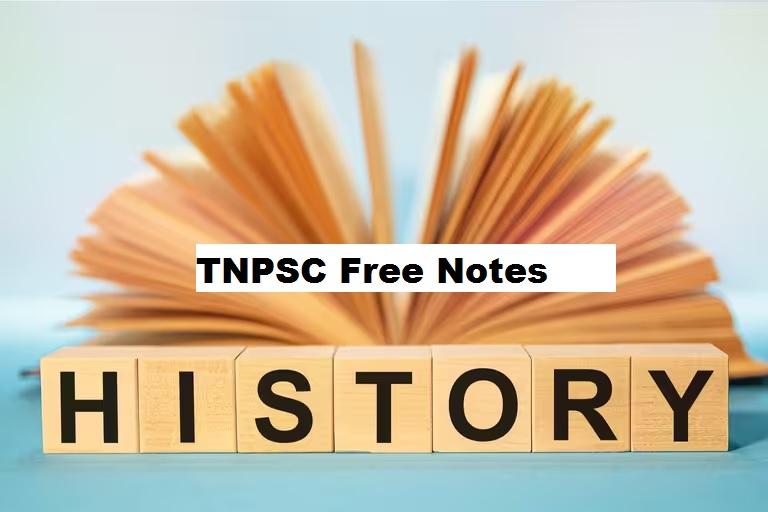இந்தக் கட்டுரையில், TNPSC குரூப் 1, குரூப் 2, குரூப் 2A, குரூப் 4 மாநிலப் போட்டித் தேர்வுகளான TNUSRB, TRB, TET, TNEB போன்றவற்றுக்கான முறைகள் இலவசக் குறிப்புகளைப் பெறுவீர்கள்.தேர்வுக்கு தயாராவோர் இங்குள்ள பாடக்குறிப்புகளை படித்து பயன்பெற வாழ்த்துகிறோம்.
Reforms in Tamil Nadu
The reform movements of north India had its own impact on Tamil Nadu.
Brahmo Samaj and Arya Samaj had their branches in Tamil Nadu.
Keshab Chandra Sen visited Madras and lectured here, but Tamil Nadu also saw its own
reform movements.
Ramalinga Swamigal (1823–1874)
Popularly known as Vallalar, Ramalinga Swamigal or Ramalinga Adigal was born in a
modest family in Marudhur, a village near Chidambaram in 1823.
He played a prominent role in the socio-religious reform movement in Tamil Nadu
during the 19 th century.
He spent his young age in Chennai.
Despite having no formal education, he gained an immense scholarship.
Inspired by the Saiva Thevaram and Thiruvasagam hymns, he began to compose moving
poems on his own.
Being spiritual, his songs and works were a harmonious blend of social reforms and
religious sentiments.
He tried his best to find a solution to the social evils by inculcating spiritual awareness.
Ramalinga Adigal led to the unity and solidarity of Tamils. In that sense alone, he
favoured the creation of a casteless society to be guided by God, whom he believed to
be in the form of ‘Arul Perum Jothi’.
In his time, Saiva religion was in the grip of Saiva monasteries such as those at
Thiruvaduthurai, Dharumapuram, and Thiruppanandal.
Ramalinga Swamigal’s poems expressed radical ideas and condemned bigotry and
irrationality.
He founded the Sathya Gnana Sabha (hall of true wisdom forum) in 1872 to organize his
followers and ensuring it was entirely secular.
This brought him into conflict with established Saivite orders, and matters came to a
head when his followers published his poems under the title of Thiruvarutpa (Songs of
Grace) in 1867.
Orthodox Saivites under the Sri Lankan reformer Arumuga Navalar criticised this as
blasphemous and launched a tract war.
He condemned the inequalities based on birth and promoted universal love and
brotherhood.
He showed his compassion and mercy on all living beings, including plants. This he called
Jeevakarunya (Mercy to life)
That is why he said, “Vaadiya Payirai Kandapodhellam Vaadinaen”.
He emphasised on being vegetarian.
He established the Samarasa Vedha Sanmarga Sangam in 1865 and it was renamed
“Samarasa Suddha Sanmarga Satya Sanga” which means “Society for Pure Truth in
Universal self-hood”.
He believed that hunger and poverty are the evils of society.
He advocated that feeding the poor is the highest form of worship.
He established a free feeding house Sathya Dharma Salai for everyone irrespective of
caste at Vadalur (1867), in the wake of a terrible famine in south India in 1866.
On the inaugural day, he lit the fire of the stone stove with a declaration that the fire is
ever alive and the needy shall be fed forever.
As per the declaration, it provides food to everyone irrespective of caste and creed
throughout the year.
One of the primary teachings of Vallalar is ‘Service to mankind is the path of Moksha’.
God is the personification of mercy and knowledge.
The path of compassion and mercy are the only path to God.
But ultimately, Ramalinga Swamigal’s contribution was recognised and his writings
inspired universal ideas and undermined sectarianism in the Saiva religion.
Buddhist Revivalism and Iyotheethoss Pandithar
Buddhism had been practically wiped out in the Tamil country by the beginning of the
second millennium.
Towards the end of the nineteenth century, there was a revival of Buddhism.
The publication of the complete edition of Jeevaka Chintamani (1887) and Manimekalai
(1898) were landmarks, but the most important figure was Iyotheethoss Pandithar.
Pandithar Iyothee Thassar (1845–1914) was a radical Tamil scholar, writer, Siddha
medicine practitioner, journalist and socio-political activist.
Born in Chennai, he was fluent in Tamil, English, Sanskrit, and Pali languages.
He was disappointed with the Hindu dharma, which served as the basis for propagating
and validating caste in Hindu society.
In the 1890s, he began a movement among the Adi Dravidars, arguing that they were
the original Buddhists who had been consigned to ‘untouchability’ due to their
opposition to Vedic Brahminism.
He re-read classical Tamil and other texts to make his case.
He also encouraged the conversion to Buddhism.
Influenced by the Theosophist organiser, Colonel H.S. Olcott, went to Sri Lanka in 1898
and converted to Buddhism.
In the same year, he founded the Sakya Buddhist Society at Madras to construct rational
religious philosophy through Buddhist religion.
His policy was followed by a large number of people in the northern parts of Tamil
Nadu. Many of the workers who worked in the Kolar gold field followed his policy.
In this movement, M. Singavelu and Prof P. Lakshmi Narasu also played an important
role.
He campaigned for social justice and worked for the emancipation of the
“untouchables” from the caste clutches.
He worked for the construction of a casteless identity and castigated caste hegemony
and untouchability.
He considered education as an important tool for empowerment and became the
driving force behind the establishment of several schools for the “untouchables” in
Tamil Nadu.
He founded the Advaidananda Sabha to raise the voice for the temple entry of the
“untouchables”.
In 1882, John Rathinam and Iyothee Thassar established a movement called, Dravida
Kazhagam and launched a magazine called Dravida Pandian in 1885.
He founded the Dravida Mahajana Sabha in 1891 and organised the First Conference of
the association at Nilgiris.
He started a weekly journal, Oru Paisa Tamilan, in 1907 and published it until his demise
in 1914.
**************************************************************************
| Adda247 TamilNadu Home page | Click here |
| Official Website=Adda247 | Click here |








